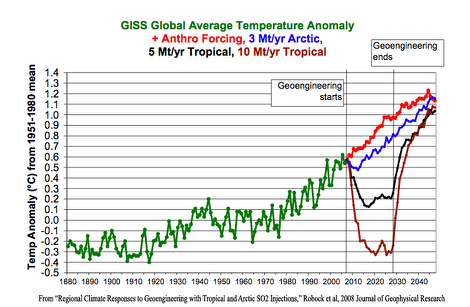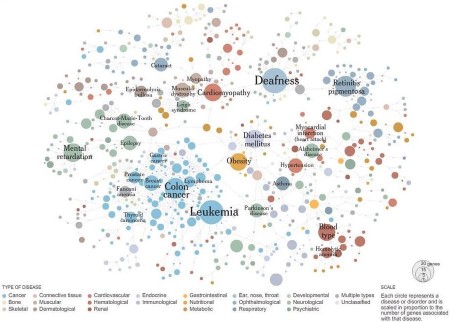 The Fermi Paradox -- if there's other intelligent life in the galaxy, given how long the galaxy's been here, how come we haven't seen any indication of it? -- is an important puzzle for those of us who like to think ahead. Setting aside the mystical (we're all that was created by a higher being) and fundamentally unprovable (we're all living in a simulation), we're left with two unpalatable options: we're the first intelligent species to arise; or no civilization ever makes it long enough. The first one is unpalatable because it suggests that our understanding of the biochemical and physical processes underlying the development of life have a massive gap, since all signs point to the emergence of organic life under appropriate conditions being readily replicable. The second one is unpalatable for a more personal reason: if no civilization ever survives long enough to head out into the stars, what makes us think we'd be special?
The Fermi Paradox -- if there's other intelligent life in the galaxy, given how long the galaxy's been here, how come we haven't seen any indication of it? -- is an important puzzle for those of us who like to think ahead. Setting aside the mystical (we're all that was created by a higher being) and fundamentally unprovable (we're all living in a simulation), we're left with two unpalatable options: we're the first intelligent species to arise; or no civilization ever makes it long enough. The first one is unpalatable because it suggests that our understanding of the biochemical and physical processes underlying the development of life have a massive gap, since all signs point to the emergence of organic life under appropriate conditions being readily replicable. The second one is unpalatable for a more personal reason: if no civilization ever survives long enough to head out into the stars, what makes us think we'd be special?
But I think there might be a third option.
(Warning: the rest hidden in the extended entry due to extreme geekitude.)
Marco...
My colleague at the IEET Nick Bostrom offers a provocative version of the consequences of the Fermi Paradox in the latest
Technology Review. In "
Where Are They?" Nick (the director of the Future of Humanity Institute at Oxford University) suggests the existence of a metaphorical "Great Filter," some phenomenon (or set of phenomena) beyond which it's nearly impossible to pass. If the Great Filter is in the past, as some biochemical hurdle making the emergence of complex life wildly improbable, then we may have a grand future ahead of us. If the Great Filter is still to come, conversely, we're likely doomed. For this reason, Nick hopes that we don't find signs of life elsewhere in the solar system.
It's not hard to imagine what a future "Great Filter" might be -- the list of potential sources of extinction is diverse. It could easily be a natural event, such as a global plague or a massive asteroid strike; perhaps more likely, it could be a human-caused event, such as catastrophic environmental collapse or global war with ultra-high-tech weapons, wiping us out past recovery. Either way, it's a depressing end, but (in this scenario) a common one.
But I suspect that the "where are they?" query has a serious flaw: it makes assumptions about the behavior of an interstellar-capable culture based on what we, a pre-interstellar society, might do. Take this bit from Bostrom's article, about self-replicating "Von Neumann machine" probes:
If a probe were capable of traveling at one-tenth the speed of light, every planet in the galaxy could thus be colonized within a couple of million years (allowing some time for each probe that lands on a resource site to set up the necessary infrastructure and produce daughter probes).
A clear argument, and one would be forgiven for missing the key word in that sentence: colonized.
The Singularity is Near? The Singularity is Calling from INSIDE THE HOUSE!
It's a reasonable assumption that a civilization capable of building self-replicating probes that can travel at 10% of the speed of light (or even 1%) would be well past the point of developing machines able to behave as sentient beings. Throw molecular nanotechnology into the mix, along with a unthinkably more advanced science's understanding of how the local equivalent of a brain works, and it's clear that an interstellar-capable civilization must also be a post-Singularity civilization, no matter how narrowly, broadly, or dismissively one defines the concept.
So why would members of a culture so advanced want to deal with colonization? It's a very human/biological concept, not one that would readily apply to a post-biological civilization. Colonization would be important if you were spreading people, but not intelligent Von Neumann machines. Gravity wells take energy to get out of. Planets can have their own replicators to deal with (organic or otherwise). A static position makes you a sitting duck for natural disasters. All of those could be dealt with, but why bother, when there so much more out there?
An Oort cloud, the shell of comets that surrounds a solar system at the outer reaches of its star's influence, would be much more appealing -- lots of fun molecules to work with, in abundance. Even the Kuiper belt, the ring of rocks and asteroids and occasional dwarf planets at the extreme edge of a solar system would be more interesting in terms of readily-accessible masses of material. Getting solar power is a non-issue, as an interstellar-capable civilization able to spread at 1% or 10% of the speed of light clearly has access to much more significant (and more readily portable) sources of energy.
To be clear, this isn't an argument that these interstellar-capable civs just sit at home. They could and would likely spread, and certainly explore. But the notion that they'd hop from solar system to solar system planting their colonies, strikes me as terribly unimaginative, and definitely a pre-Singularity perspective.
The core of the Singularity argument is that those of us on the "left of the boom" side of one simply can't understand what life is like on the "right of the boom." The demands and concerns and requirements of a post-Singularity civilization wouldn't be based on a pre-Singularity pattern. That would apply to choices made for interstellar spread, too.
Interstellar Risk
This is, to me, an arguable possibility as to why we haven't encountered extraterrestrial intelligence. It's not dead certain, however -- there could still be an interstellar culture that managed to avoid a Singularity, or still opted for colonization (or to turn every bit of non-stellar mass into computronium). But those have their own complexities, mostly revolving around the speed of light, evolution, and politics(!).
As far as we can tell, the speed of light is an absolute limit. As a result, the further out a civilization spreads from its original home, the greater the time required for the edges to speak to/trade with/learn from the center, or each other. After a few thousand light years (if not well before), the edges would be so disconnected that they'd effectively be in isolation.
What we know about groups in isolation, from both biological and sociological evolutionary models, is that they diverge. Various local conditions and particular histories set these groups along novel pathways. There's no reason why these patterns wouldn't also apply to interstellar spread. What would these variations look like? Who knows? But one thing we know about this imagined interstellar species is that it has a strong drive to spread and colonize.
So there you have a diverse (and diversifying) set of (sub-) cultures/species, all interested in spreading and colonization. Looking out into the deep dark, they'd see more systems to move to and fiddle with for a few centuries/millennia getting them set up right; looking back, they'd see lots of systems already set up to be perfectly-suited to this particular original species, or at worst easily modified. They don't all have to attack internally to disrupt the entire endeavor: some become victims, some become defenders, and some -- possibly many -- try to keep a very low profile, not wanting to become the next victim. After digesting the "old worlds," the super-colonizing culture might start to move out again, setting off another cycle. Eventually, they'd figure out that there's a limit to how far a civilization can spread before it falls apart.
One might argue that this is simply taking human history (clearly pre-Singularity) and trying to apply it to a post-Singularity culture. One would be wrong -- I'm taking a pattern repeated in evolution, the flip side of a species spreading across an environment. That it happens in politics as well as biology simply points to its universality.
...Polo!
There's one last flaw to the "where are they?" argument: it assumes that we could see them if they were there. I don't mean anything magical, just that we may not be looking in the right place, signal-wise. Advanced extraterrestrial civilizations could be using an entirely new medium for communication, one that we don't know see as possible, only having made a brief stop at radio along the way. That's possible, although given that it's dependent upon something we don't now know about, it's really just special pleading.
The issue that SETI and its related efforts can really only detect high-powered beacons is a more tangible issue. "Radio fossils," the signal leaks from radio-capable civilizations, are far too weak to be detected right now. Even our largest radio receivers are nowhere close to being able to pick up alien TV signals -- one estimate claims that we'd need a current-technology receiver larger than the diameter of the Earth to pick up UHF television signals from the nearest star system, Alpha Centauri. And when you add spread-spectrum and encryption technology, even a strong signal would likely look like noise.
To sum up:
* Current SETI couldn't detect the kinds of signals we're putting out, so may be missing abundant radio fossil traffic.
* We have no way of knowing if a post-radio communication method is in use.
* An interstellar-capable civilization would certainly be post-Singularity, and therefore have very different needs and motives for expansion.
* Interstellar-capable civilizations that somehow remain wedded to colonization would inevitably fall into internal conflict because of speed-of-light communication/travel lag and divergent evolution (social or biological).
All of this is to argue that just because we don't see them doesn't mean (a) they're not out there, or (b) we're doomed. Whew.








 The
The  Discussions of the implications of the augmentation of our biological bodies with prosthetic technologies can be found quite readily in the esoteric discourses of self-described
Discussions of the implications of the augmentation of our biological bodies with prosthetic technologies can be found quite readily in the esoteric discourses of self-described 
